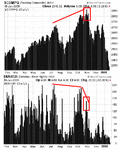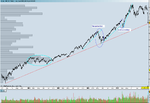Having a "roadmap" of some kind is important in order to establish what phase/trend the market and has helped me understand why price moves in the manner that it does. I realize I must therefore reconsider my position if the market shows me otherwise. Your comment about this being a bear market rally puts a lot of what I considered as clear, in doubt. I would therefore appreciate it if you could shed some light on how one could distinguish the one from the other.
I did not say that this was a bear market rally. I said that two legs suggest a bear market rally. As for the difference between a bull market and a bear market rally, this has to do with the number of legs, the slope, and the amount of time involved, among other things. Most investor dictionaries or encyclopedias will provide all the details.
I was merely thinking about how the last 5 years pan out on a different index. It just happens to be the DAX, because that's the only "major" index I keep an eye on, which still looks like it's in an uptrend. Next to that, the "corrections" (if that's what they are), are easier to distinguish than in the US indices.
Back to the (attached) DJIA I still see three similar uplegs, with a prolonged period of sideways movement going on in between the first and second. I believe you called this a "time correction" somewhere. The third upleg has the typical parabolic rise, after which volatility increased and the daily range expanded. Aren't these elements which one would expect to see in a distribution phase?
The volume's not right. But the index made a triple top anyway, suggesting that the distribution took place; it was just extraordinarily sloppy. This sloppiness may have something to do with the speed and extent of the decline.
With "usual", are you refering to time that it takes to complete a distribution phase? I thought a multiple top was an important reversal signal.
See above.
Isn't the change in the slope of each consecutive up-leg a reflection of the increased momentum that occurs while a bull market progresses?
Yes, but, again, the volume hasn't been consistent with this scenario. Therefore, one has to turn to other basics, such as new highs and volume of advancers.
I understand these are the foundations to look for conformation (or absence of ~), but what if one were to trade silver, gold, or any other commodity?
I don't trade commodities, so I can't help you there. But tangibles follow different rules than intangibles. I'm sure that the commodity threads have loads of information.




